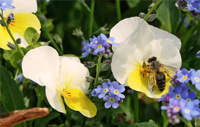
Spring marks a time of renewal and rebirth, not just for nature but for our gardens too. As the last of winter melts away, it’s the perfect opportunity to prepare your garden for the vibrant growth that lies ahead. Here are six essential tips to ensure your garden springs to life beautifully and healthily in the coming weeks and months.
- Start with a clean slate: Begin by clearing away the debris of the past season. Remove any dead plants, fallen leaves and other debris that have accumulated over the winter. This not only tidies up your garden but also prevents the spread of disease and pests.
- Prune and trim: Early spring is the ideal time for pruning. Trim back the dead and damaged branches of trees, shrubs and perennials to promote healthy growth. Remember, pruning needs vary among plant species, so make sure to follow specific guidelines for your different plants.
- Test and amend your soil: After the thaw, it’s a great idea to test your soil’s pH and nutrient levels. Most plants thrive in soil with a neutral pH and balanced nutrients. Depending on the results, you may need to amend your soil with compost, manure or pH adjusters to create the perfect growing environment.
- Plan and plant wisely: As you prepare for planting, consider the layout of your garden. Group plants with similar water, sun and soil preferences together. When it’s time to plant, start with hardy, frost-tolerant varieties and gradually move to more sensitive plants as the weather warms.
- Mulch for moisture and weed control: Mulching is a proven way to retain soil moisture, regulate temperature and prevent weed growth. Apply a 2- to 3-inch layer of organic mulch around your plants, but be careful not to smother them. Remember, mulch breaks down over time, so you’ll want to replenish it annually.
- Set up your support systems: If you plan to grow climbing plants or plants that need support, install stakes, trellises or cages early in the season. Doing this before the plants start growing helps to prevent damage to their root systems and stems.
By following these tips, you’ll not only prepare your garden for the spring thaw but also lay the foundation for a thriving garden. How do you prepare your garden for spring? Why not share your tips and suggestions with the Shopper’s Voice community!

Did you know: Create a pollinator-friendly garden
Consider planning early-blooming flowers like crocuses, snowdrops or pansies. They don’t just add a splash of color after a long winter — they’re also an important food source for pollinators like bees and butterflies.

Interesting information! Thank you for posting it!
I have a black thumb because nothing works for me. The last few years I have bought 4 tomato plants that will get tall & I might get 1 or 2 tiny tomatoes that you can’t even use or animals get to them.
The only thing I have been able to grow is Chives & Green Onions that actually survived the winter. I do need to pull the weeds out of the raised planters I have the chives in on my front porch. I have decided that I’m not going to waste the time or money on plants or seeds again. I tried Cucumbers & got 2 or 3 tiny ones, multi-color carrots & basically had nice green tops & roots.
Followed all directions & used the correct fertilizer so I give up.